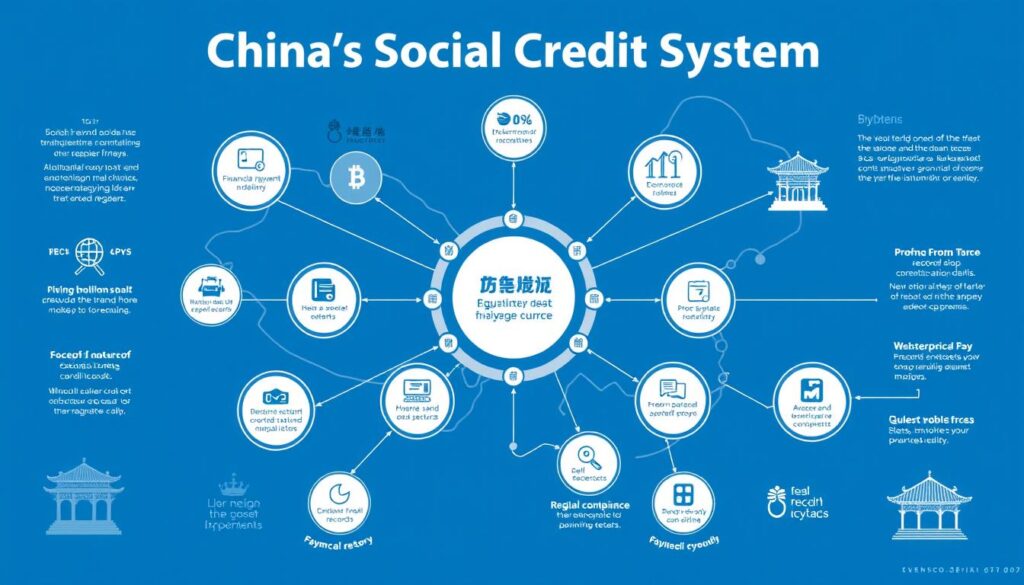
In a world increasingly driven by data, China has embarked on an ambitious project that intertwines personal behavior, financial responsibility, and social governance. The Social Credit System represents one of the most comprehensive attempts to quantify trustworthiness in human history, with profound implications for how hundreds of millions of people access financial services, secure housing, and conduct their daily economic lives.
While often misunderstood in Western media, China’s Social Credit System is neither a single unified score nor a purely dystopian surveillance mechanism. Rather, it’s a complex ecosystem of initiatives that aims to address a fundamental challenge in China’s rapidly developing economy: how to build trust in a society where traditional mechanisms have been outpaced by technological and economic change.
This article explores how this evolving system is reshaping consumer finance in China, creating new opportunities for the financially responsible while presenting significant challenges for those who fail to meet its standards. Understanding these dynamics offers valuable insights not just into China’s approach to credit, but potentially into the future of financial systems worldwide.
Data Collection and Credit Scoring Mechanisms
The Social Credit System’s foundation rests on its ability to collect, analyze, and apply vast amounts of data. Understanding what information feeds into the system and how it’s processed is essential for grasping its impact on consumer finance.
Sources of Data in the Social Credit System
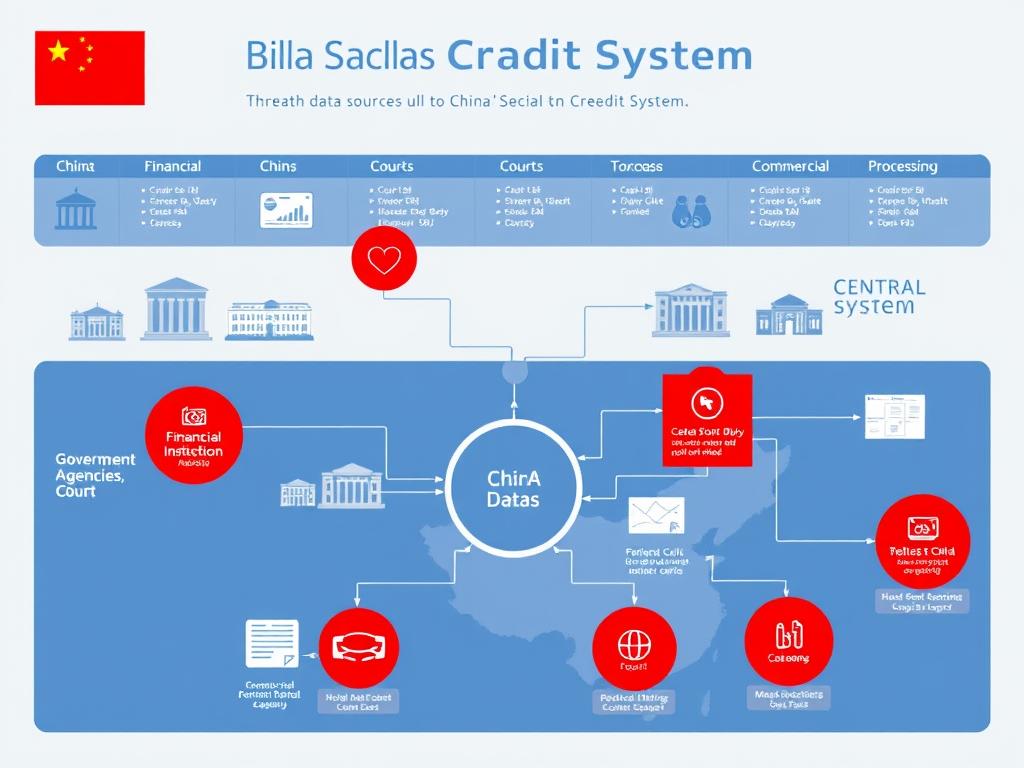
Multiple data streams contribute to social credit evaluations
The system draws information from numerous sources, creating a multidimensional view of an individual’s or organization’s behavior:
Financial Data
- Banking records and loan repayment history
- Credit card usage and payment patterns
- Tax payment compliance
- Insurance claims and premium payments
- Digital payment platform activity (Alipay, WeChat Pay)
Legal and Regulatory Data
- Court judgments and enforcement records
- Administrative penalties and violations
- Professional licenses and certifications
- Regulatory compliance history
- Contract fulfillment records
For individuals, the system may also incorporate data on social behaviors that reflect reliability and trustworthiness, though the extent varies significantly by region and implementation. These can include traffic violations, fare evasion on public transportation, and timely payment of utility bills.
Private sector credit scoring systems, such as Ant Group’s Zhima Credit (formerly Sesame Credit), incorporate additional data points from their ecosystems, including shopping habits, social connections, and even charitable donations. However, it’s important to note that these private systems are distinct from the government-led Social Credit System, though they may share some data with it.
Processing and Scoring Methodologies
How this data translates into actionable assessments varies across different components of the Social Credit System:
| System Component | Primary Data Sources | Scoring Approach | Primary Application |
| People’s Bank of China Credit Reference Center | Financial institutions, utilities, telecom | Traditional credit report (no numerical score) | Loan approvals, financial services |
| National Public Credit Information Platform | Government agencies, courts, regulators | Blacklists and redlists | Regulatory enforcement, rewards/restrictions |
| Municipal Credit Platforms | Local government data, public services | Varies by city (points, grades, or lists) | Local services, benefits, restrictions |
| Private Credit Scores (e.g., Zhima Credit) | Platform activity, purchase history, social data | Numerical scores (typically 350-950) | Platform-specific benefits, loans, deposits |
Rather than a single algorithm determining a universal score, the Social Credit System operates through a network of databases that share information. The most consequential mechanism is the blacklist/redlist system, where serious violations can place individuals or companies on blacklists with specific restrictions, while exemplary behavior can earn placement on redlists with corresponding benefits.
For financial institutions, these various data sources provide a much richer picture of potential borrowers than traditional credit histories alone, enabling more nuanced risk assessment and product offerings tailored to specific customer profiles.
Impact on Consumer Finance
The Social Credit System has fundamentally altered the landscape of consumer finance in China, creating new pathways to financial inclusion while simultaneously introducing novel barriers for those deemed untrustworthy. These effects ripple through virtually every aspect of personal financial life.
Loan Accessibility and Interest Rates
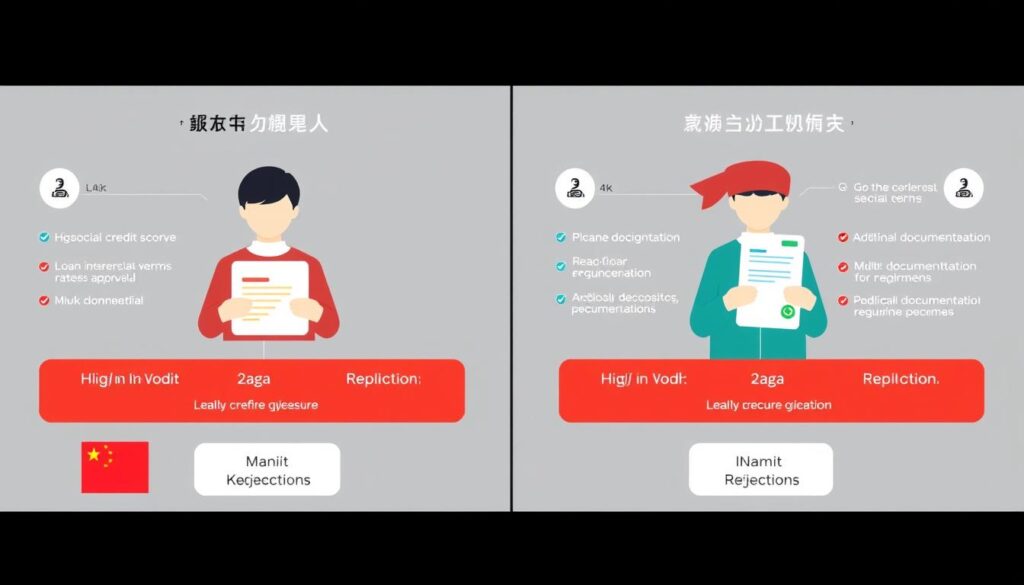
Social credit standing significantly impacts loan terms and approval rates
Perhaps the most direct impact of the Social Credit System is on an individual’s ability to access credit and the terms under which that credit is offered:
- Expanded access for the previously “credit invisible”: By incorporating non-traditional data points, the system has enabled millions of Chinese citizens without conventional credit histories to access formal financial services for the first time.
- Risk-based pricing: Lenders can offer more favorable interest rates to borrowers with strong social credit records, sometimes 30-40% below standard rates for the highest-rated individuals.
- Streamlined approval processes: High-scoring individuals often experience faster loan approvals with reduced documentation requirements.
- Loan restrictions: Being placed on a blacklist—particularly the Supreme People’s Court judgment defaulter blacklist—can severely restrict access to new credit until the underlying issue is resolved.
According to research by the People’s Bank of China, the introduction of more comprehensive credit data has reduced loan approval times by an average of 36% while increasing approval rates for first-time borrowers by approximately 25% between 2015 and 2020.
E-commerce and Digital Payment Privileges
In China’s increasingly cashless economy, social credit standing affects how individuals interact with digital payment and e-commerce platforms:
Benefits for High Scores
- Deposit-free services on sharing platforms (bikes, cars, electronics)
- Higher transaction limits on digital payment platforms
- Priority customer service on e-commerce platforms
- Access to exclusive promotions and discounts
- Expedited shipping and returns processing
Restrictions for Low Scores
- Required deposits for services that would be deposit-free for others
- Lower daily and monthly transaction limits
- Restricted access to premium services and memberships
- Exclusion from certain promotional offers
- Additional verification steps for large transactions
For example, users of Ant Group’s Zhima Credit with scores above 650 can typically rent items without deposits, while those with lower scores may need to pay security deposits of 30-100% of the item’s value. These differential privileges create strong financial incentives for maintaining good standing within the system.
Housing and Automotive Financing
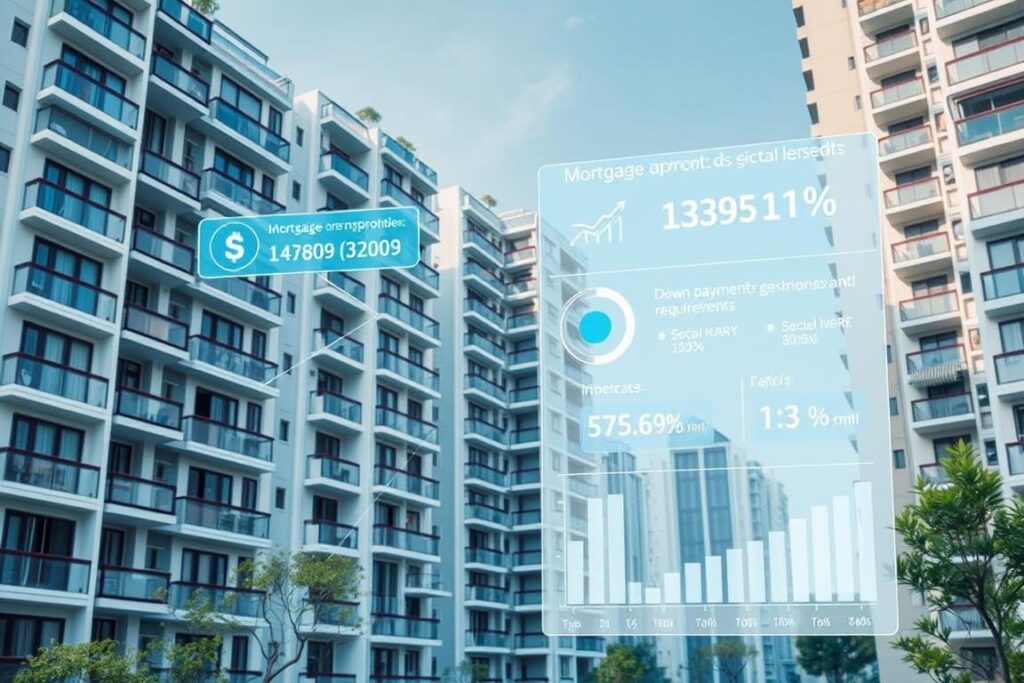
Housing finance options vary significantly based on social credit standing
Major purchases like homes and vehicles are particularly affected by the Social Credit System:
- Mortgage eligibility: Being on a blacklist can disqualify individuals from obtaining mortgages entirely, while high scores can increase approval chances and loan amounts.
- Down payment requirements: Individuals with excellent credit records may qualify for lower down payments (potentially 20% versus the standard 30% for first homes in many cities).
- Interest rate differentials: The difference between the highest and lowest mortgage rates based on credit standing can exceed 1 percentage point, translating to tens of thousands of dollars over a loan’s lifetime.
- Rental market impacts: Landlords increasingly check prospective tenants’ credit records, with some premium properties exclusively available to those with strong scores.
- Auto financing terms: Vehicle loans show similar patterns, with preferential rates and higher approval odds for those with strong credit records.
A 2019 study by the Chinese Academy of Social Sciences found that individuals on the judgment defaulter blacklist experienced a 37% rejection rate when applying for housing rentals in tier-one cities, compared to a 4% rejection rate for those not on any blacklist.
Insurance Premium Determinations
The insurance industry has embraced social credit data as a tool for risk assessment and pricing:
- Premium discounts: Many insurers offer reduced premiums (typically 5-15%) for individuals with strong social credit records.
- Coverage eligibility: Certain premium insurance products may be available exclusively to those with high credit standings.
- Claims processing: High-scoring individuals often experience expedited claims processing with fewer documentation requirements.
- Health insurance considerations: Some health insurers incorporate lifestyle data from connected platforms into their underwriting processes.
For example, Ping An Insurance, one of China’s largest insurers, offers “Good Driver” discounts of up to 15% on auto insurance for customers with clean driving records as reflected in their credit profiles, while ZhongAn Insurance provides premium reductions for health insurance based partly on lifestyle data from connected health apps.
Want to understand how China’s approach to credit scoring could impact global finance?
Download our comprehensive guide “The Global Implications of China’s Social Credit System” for in-depth analysis and expert insights on how these innovations might influence financial systems worldwide.
Real-World Examples: How Social Credit Affects Financial Opportunities
To better understand the practical implications of the Social Credit System on consumer finance, consider these real-world scenarios based on documented cases and research:
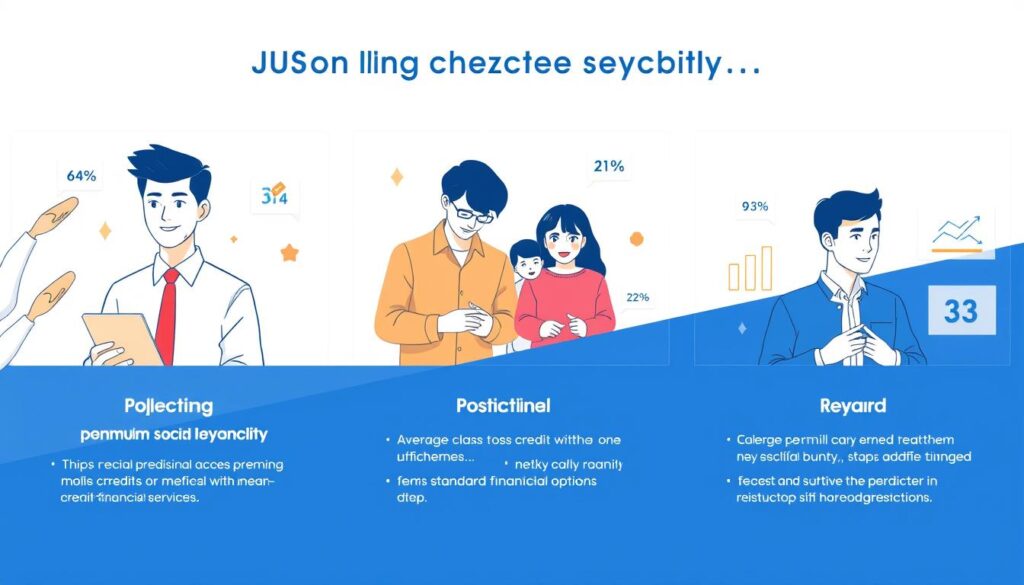
Different social credit standings create vastly different consumer experiences
Case Study 1: The High-Scoring Professional
Li Wei, a 32-year-old software engineer in Shanghai, maintains excellent financial habits and a clean regulatory record. His high standing in both government and private credit systems has created tangible financial advantages:
- Approved for a mortgage with a 20% down payment (versus the standard 30%) and an interest rate 0.5% below the benchmark rate
- Uses shared services across Shanghai without deposits, saving approximately ¥5,000 annually
- Qualifies for a premium credit card with a ¥100,000 limit and enhanced rewards
- Receives expedited processing for business license applications for his side venture
- Enjoys VIP customer service channels at his bank and preferential exchange rates
The cumulative financial benefit of Wei’s high credit standing is estimated at ¥25,000-30,000 annually through direct savings and enhanced opportunities.
Case Study 2: The Blacklisted Entrepreneur
Zhang Min, a 45-year-old small business owner in Guangzhou, found himself on the Supreme People’s Court judgment defaulter blacklist after failing to repay a business loan during a downturn. The consequences were immediate and severe:
- Unable to obtain new credit cards or loans from any financial institution
- Restricted from purchasing high-speed train tickets and flying for business travel
- Required to pay 100% upfront for any business supplies (previously purchased on terms)
- Denied rental applications for a new apartment, forcing him to pay a 50% premium for substandard housing
- Business license renewal faced additional scrutiny and delays
Zhang eventually paid his debt in full, but remained on the blacklist for an additional six months. The estimated direct and opportunity costs of his blacklisting exceeded ¥200,000 over an 18-month period.
Case Study 3: The Credit-Building Young Adult
Wang Fei, a 24-year-old recent graduate in Chengdu, had no traditional credit history but began building her profile through consistent behavior on digital platforms:
- Initially required to pay deposits for all shared services and received small credit limits
- After six months of timely utility payments and responsible use of small credit products, qualified for a ¥10,000 personal loan for professional development courses
- Participation in community volunteer activities, recorded through a municipal app, contributed to positive standing in the local credit system
- By her second year post-graduation, qualified for auto financing at standard rates despite limited income history
Fei’s experience demonstrates how the Social Credit System can create pathways to financial inclusion for young adults who would struggle to establish creditworthiness in traditional systems that rely heavily on lengthy credit histories.
Statistical Impacts Across Consumer Segments
| Consumer Segment | Loan Approval Rate | Average Interest Rate Differential | Required Deposits | Insurance Premium Impact |
| Top-tier credit standing | 85-95% | -0.5% to -1.2% | Often waived | -5% to -15% |
| Average credit standing | 60-75% | Benchmark | Standard | Standard |
| Low credit standing | 15-30% | +1.0% to +3.5% | 150-200% of standard | +10% to +30% |
| Blacklisted | Often ineligible | Full payment required | Limited eligibility |
These examples illustrate how the Social Credit System creates a highly stratified consumer finance landscape, with significant financial incentives for maintaining positive standing and severe consequences for serious violations.
Privacy Concerns and Data Security
The extensive data collection underpinning China’s Social Credit System raises important questions about privacy, data security, and potential misuse. Understanding these concerns is essential for a complete picture of the system’s implications for consumer finance.
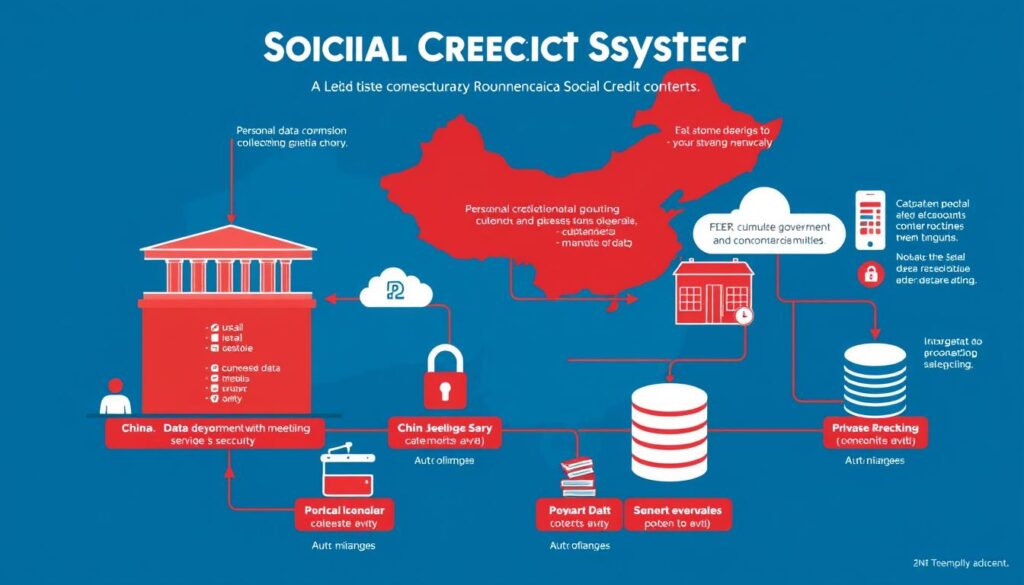
The extensive data collection of the Social Credit System raises significant privacy considerations
Data Collection Scope and Transparency
The breadth of data collection within the Social Credit System presents several privacy challenges:
- Limited opt-out options: Participation in government-run aspects of the system is generally mandatory, with few mechanisms for individuals to restrict data collection.
- Transparency gaps: While blacklists and their criteria are generally public, the full scope of data collection and analysis methods often lacks transparency.
- Data aggregation concerns: The combination of financial, legal, and behavioral data creates comprehensive profiles that exceed traditional credit reporting in scope and detail.
- Algorithmic opacity: The methods used to analyze and score data, particularly in private credit scoring systems, are often proprietary and not subject to public scrutiny.
In response to some of these concerns, Chinese authorities have taken steps to standardize data collection. In 2021, the government released the “National Basic Directory of Public Credit Information” and the “National Basic List of Punishment Measures for Untrustworthiness,” which aim to define what information can be collected and how it can be used.
Data Security Measures and Vulnerabilities
The security of the vast amounts of data collected presents both technical and governance challenges:
Security Measures
- Encryption requirements for data transmission and storage
- Access controls limiting which entities can view specific data types
- Audit trails tracking data access and usage
- Penalties for unauthorized data access or sharing
- Centralized oversight of major databases
Persistent Vulnerabilities
- Multiple databases increase potential breach points
- Varied security standards across different system components
- Authorized data sharing may exceed original collection purposes
- Limited individual recourse for data breaches
- Potential for insider threats given the value of the data
China’s 2021 Personal Information Protection Law (PIPL) has strengthened data protection requirements, but its application to government data collection, including for the Social Credit System, contains significant exemptions for public security and social governance purposes.
Recourse and Correction Mechanisms
For individuals who believe their data is inaccurate or that they’ve been unfairly penalized, several recourse mechanisms exist, though their effectiveness varies:
- Credit repair processes: Formal procedures allow individuals to address issues that led to negative credit records, though these typically require fulfilling the original obligation rather than disputing its validity.
- Administrative appeals: Decisions by government agencies can be appealed through administrative review processes.
- Judicial challenges: Courts can review certain blacklisting decisions, particularly those affecting fundamental rights.
- Data correction requests: Individuals can request corrections to factual errors in their credit records, though the burden of proof typically falls on the individual.
A 2020 study by Chinese researchers found that approximately 7.5 million individuals had successfully completed credit repair processes and been removed from the judgment defaulter blacklist, representing about half of those who had been listed.
Key Insight: While China’s approach to data privacy differs significantly from Western models like the EU’s GDPR, recent legislation suggests a growing recognition of the need to balance data utilization with individual privacy protections. The evolution of these safeguards will significantly influence public trust in the Social Credit System and its long-term sustainability.
Comparison with Western Credit Scoring Models
To fully understand China’s Social Credit System, it’s valuable to compare it with Western approaches to credit scoring and financial reputation systems. While there are fundamental differences in scope and philosophy, there are also surprising similarities worth examining.

China’s comprehensive approach contrasts with Western models’ narrower financial focus
Philosophical and Structural Differences
| Feature | China’s Social Credit System | Western Credit Models (e.g., FICO) |
| Primary purpose | Comprehensive trust assessment and social governance | Financial risk assessment for lending decisions |
| Data scope | Financial, legal, regulatory, and (in some implementations) social behavior | Primarily financial history and debt management |
| Administration | Government-led with private sector participation | Private sector-led with government regulation |
| Consequences | Affects financial services, travel, education, employment, and other domains | Primarily affects financial services and housing |
| Transparency | Varies by component; blacklist criteria public but scoring algorithms often opaque | General factors disclosed but specific algorithms proprietary |
| Regulatory framework | Developing comprehensive framework with significant government discretion | Established regulatory frameworks with consumer protection emphasis |
The fundamental difference lies in scope and purpose: Western credit systems primarily aim to predict financial risk for lenders, while China’s Social Credit System has the broader goal of promoting trustworthy behavior across multiple domains of life.
Surprising Similarities
Despite these differences, there are notable parallels between China’s approach and certain aspects of Western systems:
- Expanding data sources: Western credit scoring is increasingly incorporating “alternative data” beyond traditional credit reports, including utility payments, rental history, and even social media in some specialized applications.
- Behavioral economics: Both systems leverage behavioral incentives to encourage desired financial behaviors, though China’s approach is more explicit and comprehensive.
- Differential access: Poor credit in both systems creates barriers to financial services, housing, and certain employment opportunities.
- Digital integration: Both systems are increasingly integrated with digital platforms and payment systems, though China’s integration is more advanced.
- Public-private partnerships: Both models involve collaboration between government and private entities, albeit with different power dynamics.
For example, in the United States, poor credit scores can prevent individuals from renting apartments, increase insurance premiums by 20-50%, and affect employment prospects in finance and other sensitive sectors—consequences that parallel some aspects of China’s system.
Emerging Convergence in Some Areas
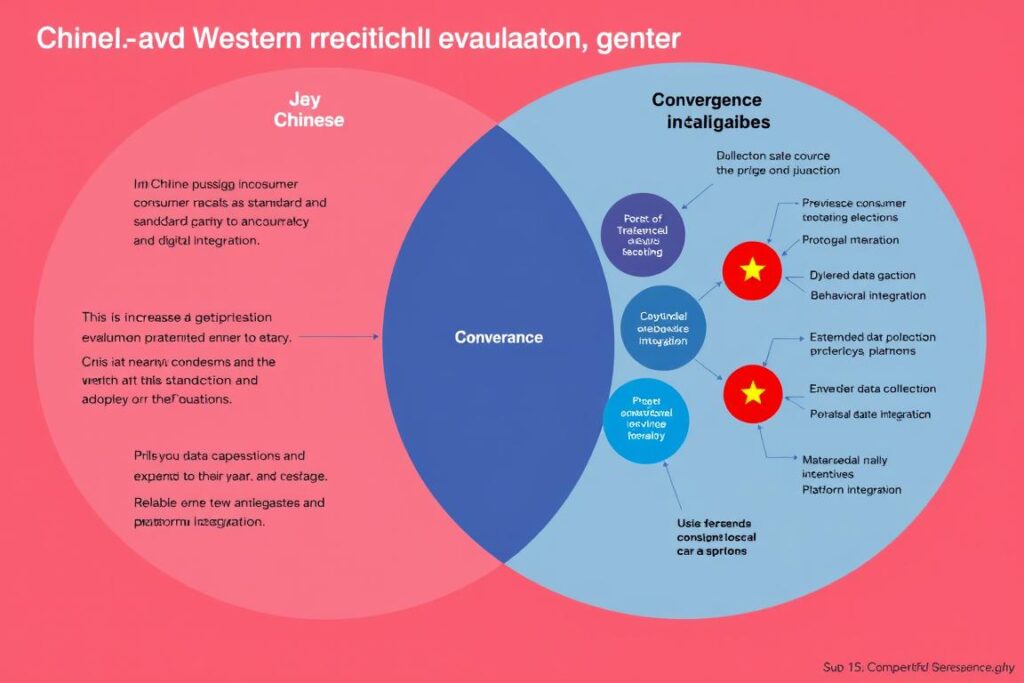
Some aspects of Chinese and Western approaches are gradually converging
Interestingly, there are signs of convergence in certain aspects of credit evaluation:
Western Adoption of Chinese Elements
- Increased use of digital payment data in credit decisions
- Growth of “alternative” credit scoring for the underbanked
- Integration of behavioral metrics into specialized lending
- Platform-based reputation systems (e.g., Uber, Airbnb)
- Rewards programs for “good” financial behaviors
Chinese Adoption of Western Elements
- Strengthened data protection regulations
- Increased standardization of credit reporting
- Enhanced consumer dispute resolution mechanisms
- More transparent scoring criteria in some areas
- Greater emphasis on financial inclusion
This convergence suggests that while the systems remain fundamentally different in their scope and governance, they may be evolving toward a middle ground in certain technical and operational aspects.
“The differences between China’s Social Credit System and Western credit scoring are more a matter of degree than of kind. Both use data to assess trustworthiness and both create differential access to opportunities. The key distinction lies in the breadth of data considered and the range of consequences applied.”
Future Outlook: Evolution and Global Influence
As China’s Social Credit System continues to develop, its trajectory will have significant implications not only for consumer finance within China but potentially for credit and trust systems globally. Understanding likely developments and their potential impact is valuable for financial professionals and policymakers worldwide.
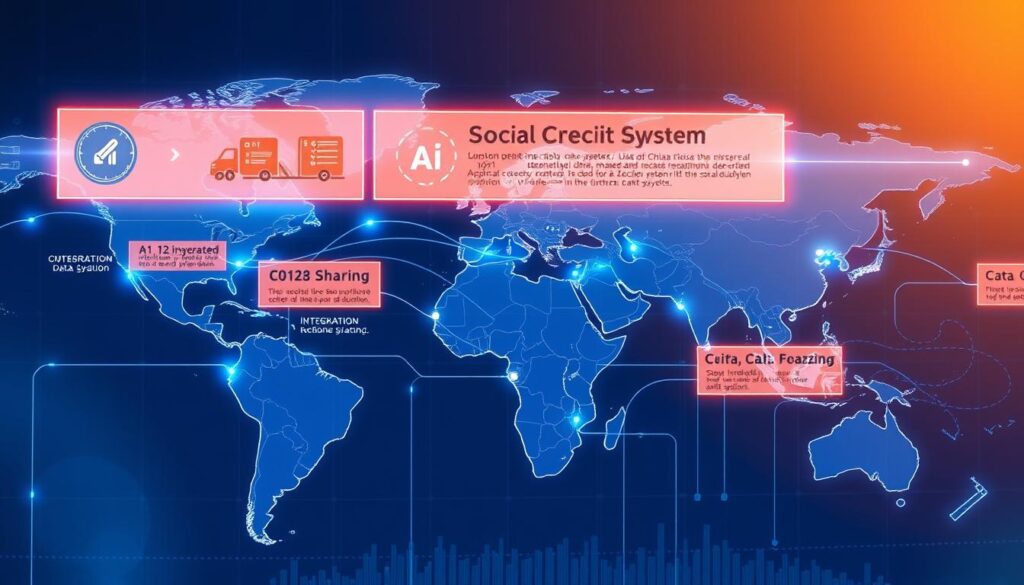
The evolution of China’s approach may influence credit systems globally
Domestic Development Trajectories
Several key trends are likely to shape the Social Credit System’s evolution within China:
- Standardization and legal framework: The ongoing development of a comprehensive Social Credit Law will likely standardize practices across regions and create more consistent implementation.
- AI and predictive analytics: Advanced algorithms will increasingly analyze patterns in credit data to predict future behavior, potentially enabling more personalized financial products.
- Integration with digital yuan: China’s central bank digital currency (CBDC) may eventually integrate with the Social Credit System, creating new possibilities for programmable money tied to credit standing.
- Enhanced privacy protections: In response to public concerns, stronger safeguards around data collection and usage are likely to emerge, particularly for sensitive personal information.
- Expanded financial inclusion: The system will likely continue to evolve mechanisms for bringing previously unbanked populations into the formal financial system.
According to the People’s Bank of China, the next phase of development will focus on creating a “more precise, scientific, and effective” credit system that balances comprehensive evaluation with appropriate boundaries on data collection.
Potential Global Influence
China’s approach to credit and trust evaluation may influence global practices in several ways:
Direct Adoption Elements
- Alternative data usage in credit scoring
- Integration of regulatory compliance into credit evaluation
- Public-private data sharing frameworks
- Digital platform integration with credit systems
- Behavioral incentives for financial responsibility
Reactive Policy Development
- Strengthened data privacy regulations
- Enhanced consumer protection in credit reporting
- Limitations on algorithmic decision-making
- Increased transparency requirements
- Ethical frameworks for comprehensive scoring
Several countries have already begun implementing systems with similarities to aspects of China’s approach. For example, Singapore’s “Creditsafe” system incorporates both financial and legal compliance data, while India’s Unified Payments Interface (UPI) is creating rich payment data that could inform future credit evaluations.
Implications for Global Financial Institutions
Financial institutions operating globally should consider several strategic implications:
- Compliance requirements: Companies operating in China will need robust systems to maintain positive corporate social credit standing.
- Data strategy: Institutions should develop frameworks for responsibly incorporating alternative data into credit decisions while respecting regional privacy norms.
- Product innovation: The success of credit products tied to behavioral incentives in China may inspire similar innovations in other markets.
- Risk assessment: Understanding how comprehensive credit systems affect consumer behavior and default patterns will be increasingly valuable.
- Ethical considerations: Financial institutions will need to develop clear positions on the appropriate boundaries of credit evaluation as these systems evolve.
Key Insight: While few countries are likely to adopt China’s Social Credit System in its entirety, many of its technical innovations and approaches to alternative data are likely to influence credit evaluation globally. Financial institutions that understand these developments will be better positioned to navigate the evolving landscape of trust and reputation systems worldwide.
Conclusion: Balancing Innovation and Concerns
China’s Social Credit System represents one of the most ambitious attempts to quantify and incentivize trustworthiness in human history. Its impact on consumer finance has been profound, creating new pathways to financial inclusion while simultaneously introducing novel mechanisms for enforcement and compliance.

The system presents both significant opportunities and substantial challenges
Benefits
- Expanded financial access for previously underserved populations
- Reduced friction in digital transactions through trust verification
- Stronger incentives for contractual compliance and debt repayment
- More personalized financial products based on comprehensive profiles
- Enhanced mechanisms for identifying and preventing financial fraud
Concerns
- Potential for privacy infringement through extensive data collection
- Risk of algorithmic bias or discrimination in scoring mechanisms
- Possible chilling effects on legitimate consumer complaints
- Challenges in data security and protection from misuse
- Potential for mission creep beyond appropriate boundaries
As the system continues to evolve, finding the right balance between these benefits and concerns will be crucial for its long-term sustainability and effectiveness. Recent policy developments suggest a growing recognition of the need for appropriate boundaries and safeguards, particularly around data collection and blacklisting criteria.
For financial professionals and policymakers outside China, the Social Credit System offers valuable lessons about both the possibilities and pitfalls of comprehensive trust evaluation systems. While few countries are likely to adopt China’s approach wholesale, many of its innovations in alternative data usage, digital integration, and behavioral incentives may influence credit practices globally.
The most productive approach is neither uncritical embrace nor wholesale rejection, but rather a nuanced understanding of how different elements of the system function and their implications for consumers, businesses, and society. By studying China’s experiment with comprehensive credit evaluation, we gain insights that can inform more targeted innovations in financial inclusion and risk assessment worldwide.
Need expert guidance on navigating China’s financial landscape?
Our team of financial consultants specializes in helping businesses and individuals understand and adapt to China’s unique credit environment. Schedule a consultation to discuss your specific situation and receive tailored recommendations.
Frequently Asked Questions
Is there a single “social credit score” that applies to all Chinese citizens?
No. Contrary to common misconceptions, there is no single, unified social credit score that applies to all Chinese citizens. The Social Credit System consists of multiple initiatives operated by different government entities and private companies. These include the People’s Bank of China’s credit reporting system, the Supreme People’s Court’s judgment defaulter blacklist, various regulatory blacklists, and private credit scoring systems like Zhima Credit. Each has different criteria, scoring methods, and consequences.
How does the Social Credit System affect foreigners doing business in China?
Foreign individuals and businesses operating in China are subject to the Corporate Social Credit System, which evaluates compliance with Chinese laws and regulations. This can affect a range of business operations, from licensing and customs clearance to tax treatments and government procurement opportunities. Foreign businesses need to maintain good standing by ensuring timely tax payments, proper licensing, environmental compliance, and fulfillment of contractual obligations. Poor corporate social credit can result in increased inspections, higher compliance costs, and restricted business opportunities.
Can individuals check their social credit standing?
Yes, but the process varies depending on which component of the system you’re checking. Individuals can access their financial credit report from the People’s Bank of China’s Credit Reference Center. They can also check if they’re on any public blacklists through platforms like Credit China (信用中国) or the National Enterprise Credit Information Publicity System. For private credit scores like Zhima Credit, individuals can check their status through the respective apps. It’s important to note that there’s no single place to check one’s complete “social credit” status across all systems.
How can someone repair their credit standing if they’ve been blacklisted?
Credit repair processes exist for individuals and businesses that have been blacklisted. The specific requirements depend on the nature of the violation and the blacklisting authority. Generally, the process involves:
- Fulfilling the original obligation (e.g., paying a court judgment or fine)
- Submitting a formal application for credit restoration
- Providing evidence of compliance and commitment to future trustworthiness
- Waiting for the application to be processed (typically 1-30 days)
For serious violations, there may be a mandatory waiting period before full credit restoration is possible. Some blacklists, such as the Supreme People’s Court judgment defaulter list, allow for expedited removal once the underlying judgment is satisfied.
Are Western countries developing similar systems?
Western countries are not developing comprehensive social credit systems comparable to China’s approach. However, some elements that parallel aspects of China’s system do exist in Western contexts:
- Credit scoring systems that affect access to financial services and housing
- Background checks that impact employment opportunities
- No-fly lists and other security-related restrictions
- Digital platform reputation systems (e.g., Uber, Airbnb ratings)
- Insurance telematics that monitor driving behavior
The key difference is that these Western systems are generally more limited in scope, not centrally coordinated, and subject to stronger privacy protections and due process requirements.

Adam G
This post was created by Adam G, a seasoned financial writer with a passion for explaining currency exchange and market movements
